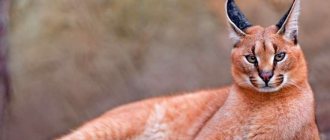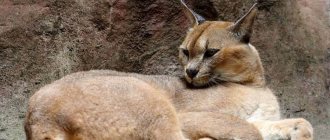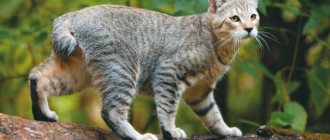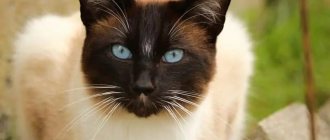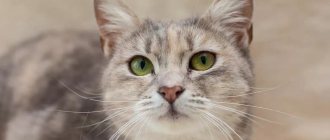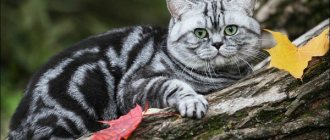- Posted by Olga Arkhipova
- Date: March 21, 2018
Caracals are predators of the cat family, distinguished by long black tufts on their ears. These are very capricious and demanding animals. However, with proper care and caring attitude, desert cats will become loyal and devoted friends to their owners.
- 2 Where does the caracal live
2.1 Video: caracal
- 3.1 Video: caracal hunting
- 4.1 Video: caracal at home
History of the breed
The desert lynx is easy to tame. Thus, the ancient Turks and Kazakhs from the poor classes took a tamed caracal with them to hunt, using it to catch hares, antelopes, and birds. Over time, the fashion for such hunting fell away. Thus, the need to tame the desert lynx also disappeared.
Until the 80s of the last century, representatives of the Caracal cat breed were found only in the wild and zoos. At the Moscow Zoo, an ordinary cat once wandered into the enclosure of a desert lynx, and then gave birth to a kitten of an unusually beautiful color. In addition, small tassels hung from the ears of the newborn purr.
The news of an accidental interspecific crossing, which was crowned with success, quickly spread throughout felinological circles. Breeders began to breed another breed of cats.
Meanwhile, over time, the popularity of Caracal cats - beautiful animals that are not difficult to tame - has sharply increased among exotic lovers.
A cross between caracals and domestic cats has been officially registered as the caraquet breed.
Abyssinian cat
Abyssinians actually look very much like a wild cat. Either a cougar or a lynx. Golden or green eyes with dark rims, “wild coloring” and flexibility of the body create that very charm of a wild animal. In addition to their striking appearance, Abyssinians are one of the smartest cat breeds. They can even be trained.
Peculiarities:
- Height up to 30 cm, weight up to 6 kg;
- An energetic, ancient and highly intelligent breed;
- They love to climb vertical surfaces;
- Price from 20,000 rub.
Abyssinian cat
Description of caracal
From the description of the breed it is clear that the desert cat Caracal is similar to a lynx in some features: ears with tassels, round pupils, large limbs, and a muscular body.
Otherwise, she looks like an exceptional individual:
- Folding graceful body measuring 65–85 cm in length. Height at withers 40–45 cm.
- A long tail.
- Small head.
- Elongated muzzle. There are black eyeliners around the eyes and also on the cheeks.
- Large dark nose with a pink mark in the middle.
- Protruding black ears 4–5 cm high with black crescent-shaped tassels. The inside of the ears is “trimmed” with white edging.
- Long massive limbs.
- Short six medium firmness.
The desert lynx has a monochromatic sand color with a red or brownish tint. The belly, neck and chin are painted white.
The weight of an adult animal can vary between 12–18 kg.
Caraquet
Caracal (caracal + cat) is a hybrid of a male caracal and a domestic cat. Kittens inherit their appearance from their father, and their calm character from their mother. The breed was bred by chance 30 years ago, and in 2018, the first caraquet nursery was opened in Russia, in Krasnodar.
Peculiarities:
- Height up to 45 cm, weight up to 16 kg;
- Caracats cannot meow, they rather yap or chirp;
- The caraquet has dog-like habits: they fetch things, become attached to the owner, walk on a leash;
- They must be fed with small poultry and meat;
- Caracat can be type F1 (direct descendant of caracal), F2 ("grandson" of caracal, 25% wild genes), F3 (third generation from wild caracal, the most domestic and do not have the bright appearance of a wild cat);
- Price from 100,000 rub.
Photo of a caracat - a cat very similar to a lynx.
Character and education
When purchasing a caracal desert lynx for themselves, cat lovers should remember that a predator always remains, first and foremost, a predator.
When raising such a pet, you need to be extremely consistent, specifically put forward your conditions, slowly accustoming the new “family member” to subordination, as well as appropriate behavior in your home.
The desert lynx is distinguished by the following character traits.
- Phlegmatic calm.
- Good nature.
- Passion for various games.
- Owner's instinct. If a tamed desert lynx always tries to get along with other pets living together, cats, dogs, parrots, then it will drive away other people's animals that accidentally enter their territory.
- Curiosity. The cat will be the first to run to the threshold, barely hearing footsteps outside the door. She will also immediately rush to the bushes as soon as they move.
American Bobtail
This is a relatively new breed that appeared in the States in the 60s of the 20th century. From childhood, kittens look like little lynxes: they are born with short tails and fluffy wings on their cheeks. The spotted or striped color gives it an additional resemblance to a lynx. The American Bobtail has hind legs that are slightly longer than the front legs, like a lynx. Therefore, even the gait resembles a trot. Despite all this, the American Bobtail is a very gentle and domestic creature.
Peculiarities:
- Height up to 30 cm, weight up to 6 kg;
- Quickly find a common language with people, cats, dogs;
- They become attached to a person;
- They tolerate moving well and adapt quickly;
- Price from 10,000 rub.
American Bobtail
Hurry up, choose a box and find out what gift awaits you
Discount on pet insurance
Promo code copied to clipboard
Care and maintenance at home
If a wild caracal cat is placed in a domestic environment, it will require appropriate care.
The desert lynx should be brushed no more than once every 6–7 days.
You should only bathe your cat if its fur is very dirty. These pets love water treatments - they will happily splash around in the bathtub with rubber ducks.
The cat's claws on the front paws are “cut” with a laser in veterinary clinics or nurseries. The pet’s claws on the hind legs will have to be sharpened yourself.
In addition, you will need to clean your four-legged pet's eyes and ears once a week.
Such purrs are pets of a relatively symbolic species. The caracal belongs to the category of tamed pets. These domesticated predators simply need fresh air, so they should be walked as often as possible, kept on a leash.
Caracal cats are best owned by owners who have their own private home, so that the desert lynx can be given free range in the yard.
What to feed a caracal
The diet of a domestic caracal should include:
- meat (beef, rabbit);
- poultry (quail, chickens);
- feed rats and mice;
- eggs.
It is advisable for the cat to eat live food.
In rare cases, it is permissible to feed commercial premium food specially designed for Maine Coons.
Domesticated desert lynxes should always have free access to water. These pets should be fed twice a day. Give your cat a fasting day every 1.5–2 weeks, give them only water.
Diseases of the steppe lynx and their prevention
The care and health of a domestic caracal are interconnected things.
These animals are naturally endowed with strong immunity. However, they will need to be taken to the doctor regularly for checkups and vaccinations.
Caracal cats should not be fed pork to avoid the development of pseudorabies.
Lifestyle of the steppe lynx
The life of a wild caracal kitten begins after 75–80 days of the female's pregnancy. As a rule, there are no more than three cubs in a litter. The litter is born blind, and only two weeks later the kittens begin to see. Until this moment, the female jealously guards the offspring, hidden in a gorge or an abandoned hollow of a fallen tree.
Female steppe lynx are caring and zealous mothers
The color of caracal cubs differs from the appearance of adult individuals due to the large number of dark specks on their fur. Over time, only the muzzle remains spotted.
A month after birth, the kittens begin to develop the territory near the den, and after another month the female transfers the babies to solid food.
Regarding the latter, it is worth noting the following:
- Caracals feed mainly on small rodents and birds like guinea fowl;
- Steppe lynxes forage for food at night;
- These animals hunt, reaching prey with the help of large jumps (up to 5 meters in length) or waiting at watering holes;
- These cats make caches of food high in the trees.
Since the animal is accustomed to life in arid areas, the caracal can go without drinking for a long time - for up to ten days, this cat is able to obtain liquid only from food. In this case, the diet of the desert lynx is expanded by including grass and berries (for example, grapes) in the menu.
Caracals are dexterous and intelligent predators, skillfully camouflaging themselves among thickets of bushes. So these animals have few enemies. The main threat comes from birds of prey during the period of raising their offspring. And for adult individuals, lions and hyenas become enemies if the animal lives in African savannas, or steppe wolves and alabai guarding sheep (when it comes to Kazakh or Turkmen steppe lynxes).
Hunting for caracal is prohibited in the countries of the former USSR, since the species is on the verge of extinction. At the same time, these animals do not take root in zoos. Therefore, nature reserves and sanctuaries are organized in the habitats of desert lynxes.
However, local residents often engage in poaching of steppe lynx due to the threat of a reduction in livestock numbers.
Video: caracal hunting
Reproduction and care of offspring
Caracals “walk” all year round. The female desert lynx usually has several partners at the same time. She raises the cubs herself. During fruiting, which lasts up to 3 months, she arranges several reliable shelters in hidden places.
Usually such cats give birth to 2-3 caracal kittens. To protect their offspring from other predators, the desert lynx carries its kittens from shelter to shelter every day.
In the first month, kittens eat only mother's milk. Then the cat gradually accustoms them to solid food, teaches them the intricacies of hunting, and then says goodbye to them as soon as the offspring have reached six months of age. Young caracals, “set free”, settle near their mother’s den.
Wild lynxes live 11–14 years.
Norwegian forest
If you compare a wild lynx in a winter coat and a domestic Norwegian forest cat, you will see how similar they are. Especially if the Norwegian Forest is gray or tortoiseshell in color. All cats of this breed have charming fluffy ears with tufts. The Norwegian forests are famous for their tranquility. They are great companions, smart and slightly introverted.
Peculiarities:
- Height up to 40 cm, weight up to 10 kg;
- Long soft coat that needs careful grooming;
- Price from 5,000 rub.
Norwegian forest
How much does a kitten cost and how to choose
Felinologists do not advise buying a desert lynx kitten from breeders with an unverified reputation, even if the caracal is sold at a price that is tempting for cat lovers.
It is not uncommon for sick or wild pets to be sold without the proper package of documents. It is better to give preference to certified nurseries. A lynx kitten is expensive - after all, it is an exotic pet.
Caracals cost about 430–480 thousand rubles in Russia. You can buy these expensive cats, for example, in Moscow. There are 4 nurseries in the capital.
There is one nursery in Kyiv. There, domesticated steppe lynx can be purchased for approximately 200–220 thousand hryvnia.
Animal health
The health of domestic lynx is usually excellent. Vaccination helps protect your cat from a number of possible cat diseases. The first vaccination is given at 10-12 weeks, and all others strictly according to the schedule suggested by the veterinarian.
Once a year, they are vaccinated against feline panleukopenia, rhinotracheitis and calcevirosis, and antiparasitic treatment is carried out.
There is a separate issue of castration. If the owner is not a professional breeder, he will be advised to neuter the caracal at 9 months. This will protect the family from aggressive splashes and unpleasant odors.
Breeding can be done all year round. During this time, the female can have three offspring with the birth of 1-6 babies at a time. The female and male get used to each other within 2 weeks. Pregnancy is long - 78-81 days.
The breed may develop Aujesz's disease, pseudorabies. To prevent such a disease, pork is not added to the diet.
How long do domestic caracals live?
When purchasing such an exotic pet, you want it to please you with its presence for as long as possible. The question of how long Caracal cats live is relevant for owners.
The lifespan of a caracal is 15-20 years.
, if the owner takes care of them as expected.
Origin
In ancient times, some wild cats were domesticated by people. The main purpose of domestication is hunting game. The steppe lynx was one of the first cat breeds that was decided to be domesticated and taught to live among people. The animal is distinguished by high intelligence, flexible mind, but besides this, it is obedient, devoted and loves its owner very much. Richer owners preferred to acquire cheetahs, which are more expensive. A baby caracal cost relatively little money, so people who were not so wealthy chose them as companions.
Trophies of an adult animal:
- hares;
- small ungulates;
- feathered.
Now the wild desert cat often lives in private homes with wealthy owners. This breed is expensive, and a lot of money goes into its maintenance. However, the owners note that the pet, raised from an early age, has a balanced, soft, playful character. The cat is graceful and very beautiful. The breed is especially popular among Arabs and Indians. Noble nobles buy exotic caracals, which always accompany their owners.
The right diet
A very important aspect in keeping an unusual pet is the caracal’s nutrition. Fortunately, you won’t need too complex or exotic products here.
The domesticated caracal happily eats almost any meat product. For example, he does not refuse rabbits, gophers and other rodents. He enjoys eating beef and chicken, including boiled chicken. It would be a good idea to include fish in your diet - sea fish can be given raw, but freshwater fish must be cooked to ensure that the eggs of parasites are destroyed.
Also, do not forget to give your pet minerals and vitamins. You can dissolve them in water or simply mix them with meat.
But it is not advisable to feed a caracal pork. Fatty meat can lead to serious obesity - the animal moves little and may develop health problems over time.
What does it eat?
As mentioned above, the caracal is not too picky about food. He is ready to eat almost any prey that he can catch and kill
Therefore, quite often its diet consists of various rodents - gophers, jerboas and gerbils. In some cases, tolai hares may become victims. And if you’re lucky, the caracal can easily cope with small antelopes or goitered gazelles that have strayed from the herd.
However, the diet often includes more exotic prey. For example, caracals do not disdain hedgehogs and reptiles. If there is no prey for a long time, they may well feast on insects. In regions where such prey lives, it may attack a mongoose or a young ostrich.
But caracals do not feed on carrion - the too pungent smell emanating from rotten meat permeates the dense skin of the predator and may well play a bad joke during an ambush hunt. Although, if fresh remains from the recent food of another predator come across, the caracal will not demonstrate excessive disgust.
Caracal protection
The African population of caracals is described in Appendix II of CUTEC, but the Asian populations are described in Appendix I of CUTEC. In this regard, hunting such animals is prohibited in many countries in Asia, as well as Africa. As for the Namibian and South African populations, caracal hunting is permitted here only to protect livestock.
In addition, it is believed that these predatory animals are on the verge of extinction in other countries, such as Pakistan, Jordan, and northern Africa. However, populations are at a stable level in southern and central Africa. The caracal trade is practiced in many countries around the world. Here they are kept as pets. These are countries such as the USA, Russia, Canada and the Netherlands. Although the scale of trade is quite small, there is a tendency that the scale of trade in these animals may increase.
Caracals have been listed as Least Concern by the IUCN since 2002. This animal lives in 50 countries around the world where there are no threats to the continued existence of these predators. Naturally, trends in human development are increasingly negative for living nature. The number of people living on our Planet is increasing, so the intensity of their interference in the natural environment is increasing, which negatively affects its inhabitants.
